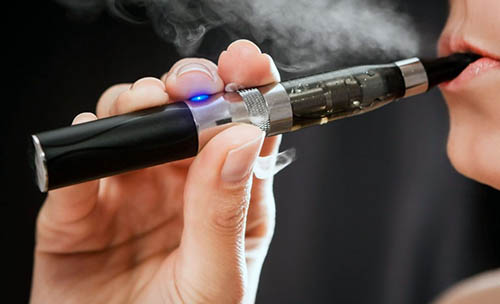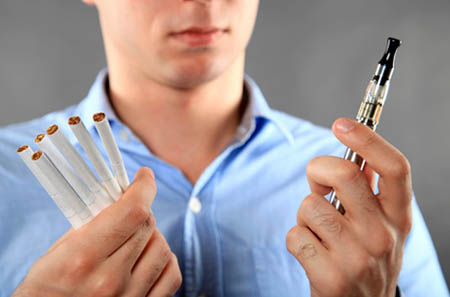‘Vaping’ means inhaling the water vapor produced by a personal vaporizer or electronic cigarette. It is not the same as smoking, because the concentrates are heated rather than burned, and water vapor is produced rather than cigarette smoke and ash.
Is Vaping Better Than Smoking Cigarettes?
“What’s fly about the vaporizer movement is that it’s clean and convenient.” –Snoop Dogg, Rapper
Vaping is a relatively recent pastime, but several promising studies have shown that it is much safer to vape than to smoke tobacco.
| ANALOG CIGARETTES | PERSONAL VAPORIZER |
| Contain nicotine | Nicotine is optional |
| Contain tar | Tar free |
| Hidden ingredients | No hidden ingredients |
| 4000 chemicals and carcinogenic compounds | Only 2 to 6 ingredients in concentrate |
| Dangerous secondhand smoke | No secondhand smoke |
10 reasons to switch to vaping
- Better health
- No offensive second hand smoke
- No fire or flame, therefore no smoke, ash or butts
- Less waste
- No more yellow fingers and bad breath
- Completely odorless, vapor smell doesn’t cling to clothes and hair
- More cost effective than cigarettes
- Discreet; can be used almost anywhere
- No social stigmas
- Many workplaces allow vaping
“I started vaping about a week ago, and I don’t enjoy smoking cigarettes any more since I switched. Cigarettes taste bad to me now, and the tobacco smoke bothers me when I inhale it into my lungs. Everything smells so much better, and my food tastes nicer too. Best of all, my horrible smoker’s cough is going away. I’m so glad I finally decided to switch!” –C.M., Administrator
Is Vaping Legal?
Because of the novelty of the technology and the possible relationship to tobacco laws and medical drug policies, personal vaporizer legislation and public health investigations are currently pending in many countries. Current regulations vary widely, from regions with no regulations to others banning the devices entirely. With an absence of federal regulations, many states and cities have adopted their own regulations, most commonly to prohibit sales to minors.
California Governor Arnold Schwarzenegger vetoed a bill that would regulate the sale of electronic cigarettes within the state on the grounds that “if adults want to purchase and consume these products with an understanding of the associated health risks, they should be able to do so.”
Therefore, if you are over 18 years of age, it is legal to vape anywhere in the USA where smoking is permitted, and even in some places where it is not. (It is generally proper to ask before vaping indoors so that you don’t alarm restaurant or store owners who are unaware of what a vape pen is.) Legislation in other parts of the world varies widely, so it would be wise to check with the relevant Consulate or Embassy before taking your vape pen abroad.
As of 2012 there are only 2 places where vaping is NOT permitted indoors: Suffolk County, New York and New Jersey. Obviously, it would only be proper to ask before you vape indoors so you don’t alarm store owners unaware of what it is.
What Do The Juices Contain?

Want To Know What You’re Ingesting?
E-juice, also known as vape juice, e-liquid or vape oil, consists of between two and six ingredients. There are no other additives or hidden ingredients; what you see is what you get. The ingredients can be divided into four elements:
- 80%-90% Vegetable glycerine (VG) base. This acts as a carrier for the flavour (and nicotine, if added), and is often mixed with propylene glycol (PG) and/or polyethylene glycol (PEG). The higher the proportion of propylene glycol in the mixture, the thicker the clouds of vapour will be.
- 10%-20% Flavor. Either food grade flavorings, such as those used in candy making, or essential oil essences, such as spearmint.
- 0%-2.4% Nicotine, depending on strength.
- Distilled water is sometimes used for dilution.
Are They Safe To Ingest?
Vegetable Glycerin (VG)
Also known as glycerol or glycerine, this sugar alcohol compound is colorless and odourless. Although it tastes sweet, it does not feed the bacteria that can cause plaque and lead to tooth decay. Vegetable glycerine is generally considered non-toxic, and can be found in many foods, beverages, pharmaceuticals and personal care items.
Vegetable glycerine is added to frosting icing to prevent it from drying out, and is used as an additive in ice cream and other frozen desserts. Glycerin soap is often used by people with sensitive, easily-irritated skin because its moisturizing properties prevent skin from drying out.
| INDUSTRY | PURPOSE |
| Food | Serves as a humectant (i.e. keeps things moist), solvent, sweetener and filler. |
| Beverage | Used as a thickening agent in liqueurs. |
| Pharmaceutical | Used in allergen immunotherapies, cough syryps, elixirs and expectorants. |
| Personal care | Toothpaste Mouthwash Skin-care products Soap Water-based personal lubricants |
Propylene Glycol (PG)
Glycols in general are non-corrosive and have very low toxicity. This clear organic compound is colorless, nearly odourless and tastes faintly sweet. Propylene glycol is considered generally recognized a safe (GRAS) by the U.S. Food and Drug Administration (FDA). It shows no evidence of being a carcinogen or of being genotoxic.
Propylene glycol is used in many foods and pharmaceuticals. It is used as a direct food additive in frozen foods such as ice cream and frozen desserts. In pharmaceuticals, it is used as a solvent in many oral, injectable and topical (cream or gel) formulations.
A few vapers have found that propylene glycol gives them a dry throat, and occasionally mild allergic reactions. If you experience these symptoms, it is recommended that you switch to a 100% vegetable glycerine e-juice.
Polyethylene Glycol
This polyether compound has a low toxicity. It is used commercially in food, cosmetics, pharmaceuticals and biomedicine.
| INDUSTRY | PURPOSE |
| Food | Anti-foaming agent |
| Pharmaceutical | Solvent base in ointment, suppositories and tablets, laxatives, and lubricating eye drops |
| Cosmetic | Base of skin creams and personal lubricants. Often combined with glycerin |
Nicotine
Arguably the most dangerous and controversial e-juice ingredient, nicotine is a potent alkaloid found in the nightshade family of plants (Solanaceae). Nicotine constitutes approximately 0.6% – 3.0% of the dry weight of tobacco, and when extracted in its pure form is a yellowish oily liquid. In smaller doses, nicotine acts as a stimulant, while high amounts of 50-100mg can be harmful. It is unlikely that a person would overdose on nicotine through smoking or vaping alone, although overdose can occur through the combined use of nicotine patches and nicotine gum while also smoking cigarettes.
Spilling a high concentration of nicotine onto the skin can cause intoxication or even death, since nicotine readily passes into the bloodstream. The nicotine density of e-liquid is rated in mg/ml (milligrams per millilitre), often shortened to mg. If in doubt, we recommend that you start with a lower density and work your way up to one you are comfortable with. As a reference, an average of between 1mg and 3mg is absorbed when you smoke a cigarette.
| E-JUICE LABEL | CIGARETTE EQUIVALENT | NICOTINE DENSITY |
| 0mg | – | No nicotine |
| 1mg – 6mg | Ultra Light | Low density |
| 7mg – 12mg | Medium | Medium density |
| 13mg – 18mg | Regular | High density |
| 19mg – 24mg | Strong | Extra high density |
| 25mg + | Super Strong | Ultra high density – use caution! |
Nicotine is unique, as its effect changes from stimulant to sedative / pain killer depending on dosage and length of use. First, by releasing glucose from the liver and adrenaline from the brain, it causes stimulation. Users report feelings of relaxation, sharpness, calmness and alertness. Some smokers may lose weight as a consequence of nicotine reducing the appetite and raising the metabolism. At higher doses, nicotine enhances the effect of serotonin and opiate activity in the central nervous system, producing a calming, pain-killing effect.
Short-term Side Effects
Nicotine increases blood pressure and heart rate and primarily causes a light head in humans.
Consumption Of Nicotine Over An Extended Period Of Time
| BODY PART AFFECTED | LONG-TERM SIDE EFFECTS |
| Blood | Increased clotting tendency |
| Lungs | Bronchospasm |
| Muscular | Nausea, dry mouth, dyspepsia, diarrhea, heartburn |
| Gastro-intestinal | Bronchospasm |
| Joints | Pain |
| Central Nervous System | Lightheadedness, headache, sleep disturbances, abnormal dreams, irritability, dizziness |
| Heart | Increased or decreased heart rate, increased blood pressure, Tachycardia, More (or less) arrhythmias, Coronary artery constriction |
| Endocrine | Hyperinsulinemia, Insulin resistance |
Fortunately, preliminary studies suggest that vaping e-juice WITH OR WITHOUT added nicotine gives smokers the same success rate as using traditional nicotine replacement therapy methods like patches and gum.
Can Vape Pens Be Used To Quit Smoking?

Yes. Vape pens have an extra advantage over traditional nicotine replacement therapies, in that they feel and behave like a traditional cigarette, without the smoke, tar and other harmful substances. Being able to handle and use your vape pen just as you would use a cigarette may very well give you the extra edge that you need in your battle against tobacco. You can choose an e-liquid with no nicotine, or start with one containing nicotine and gradually taper the nicotine density down. The American Association of Public Health Physicians (AAPHP) suggests that those who are unwilling to quit tobacco smoking or unable to quit with medical advice and pharmaceutical methods should consider other nicotine-containing products such as electronic cigarettes for long term use instead of smoking.
The British Medical Association (BMA) encourages health professionals to recommend conventional nicotine replacement therapies, but for patients unwilling to use or continue those methods, they say health professionals may present e-cigarettes as a lower-risk option than tobacco smoking.
A 2013 randomized controlled trial found no difference in smoking cessation rates between e-cigarettes with nicotine, e-cigarettes without nicotine, and traditional NRT patches.
Side Effects of Quitting “Cold Turkey”
Many people who quit smoking “cold turkey”, that is, without the aid of any nicotine replacement therapy, report adverse physical side effects including:
- Pimples and other skin problems
- Bleeding gums
- Susceptibility to colds and ‘flus
- Anxiety
- Constipation
- Increased coughing (usually a good sign!)
- Dizziness
- Insomnia
- Dry throat
Side Effects of Vaping
Many people experience no side effects whatsoever when vaping, apart from the continued usage of nicotine. When side effects do occur they tend to be temporary and easily resolved. The following side effects have been attributed to vaping:
- Dry skin
- Dry mouth
- Rash / burning feeling on face
- Itchiness
- Puffy / dry eyes
- Caffeine sensitivity
Some people who have reported side effects have persisted with vaping and found that the issues disappear after a short while without taking any sort of action. Others find that they worsen, but it is rare for people to have to stop vaping altogether due to side effects. This makes vaping an ideal solution for adult smokers who wish to continue enjoying their nicotine habit at a reduced risk.
Nicotine is not categorized as a carcinogen, but it is still essentially a poison and can increase blood pressure and heart rate in humans. Please select your nicotine-containing e-juice with caution, and rather start at a lower nicotine density and work your way up.
Vaping in the Media

Photo from NBC.com
A number of prominent celebrities have switched from smoking to vaping, including Dennis Quaid, Leonardo DiCaprio, Kevin Connolly, Trace Cyrus and Katherine Heigl.
Heigl, who showed off her vape pen on the David Letterman show, reported that she had tried to quit smoking using the cold turkey method, the patch, the gum and a drug called Chantix – all without success. Thanks to her vape pen, she is now proudly smoke-free and is feeling much better.
“My worst habit used to be smoking but I quit. “ – Katherine Heigl
“Smoking sucks! The one thing I would say to my kid is, ‘It’s not just that it’s bad for you. Do you want to spend the rest of your life fighting a stupid addiction to a stupid thing that doesn’t even really give you a good buzz?’ “- Katherine Heigl
*Disclaimer: This article is based on our personal experience, research and is not reviewed by any medical doctor. We advise you to seek your own medical advice when it comes to anything vape related.

